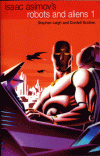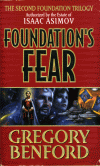My favorite science fiction writer by far is Isaac Asimov (1920-1992). One of the main reasons I started this website was to document my re-reading of his Robot and Foundation books. I recount my introduction to his writing in my post celebrating his 90th birthday. There I mention starting to read his autobiography. That actually was the first volume, In Memory Yet Green (1970) covering his life from 1920-1954. It was an out of print low quality hard back copy. I still have that volume, but for some reason I never got around to finishing it. My last bookmarked page was 167 of 708. His next volume was In Joy Still Felt (1980) covering his life from 1954-1978. I fully intended on reading both of those, then finally his third volume (for this review) I, Asimov: A Memoir (1992).
Since my post in 2010, I’ve shifted almost all of my reading to ebook formats. Unfortunately I could not find any of the old volumes on ebook. My physical copy of In Memory Yet Green sat on the shelf collecting dust, literally! Sometime last year there was a sale on this book on the Google Play Store for just a buck or two. I snatched it up immediately and put it on my short list to read after finishing John Scalzi’s Old Man’s War series which I was in the middle of at the time.
For a while I was frozen with indecision. Should I dig harder and try to find the first two volumes in ebook format? Drudge through the physical copy I had and then find the out of print second volume? Luckily I checked out some of the reviews. This third volume isn’t just 1978-(present at time of publish), but covers his entire life. The format is also not strictly chronological, but jumps from subject to subject. I was hesitant at first, partially from having a tendency to want to read things chronologically, even if they are published out of order (see my reading project). The more I thought about it, the closer I came to realizing it didn’t matter! I could read the third volume, then go back and read the first two, and maybe the third again! There is actually a 4th autobiography, It’s Been a Good Life (2002) that was edited after his death by his second wife Janet Jeppson Asimov. I plan on reading as well, possibly before the first two volumes.
If you are at all interested in Isaac Asimov, or science fiction in general, you must read this book. Having already had a false start on In Memory Yet Green, I can say I enjoyed this format better. Most “chapters,” which I will call topics, are at most five to ten pages in length. This makes for easy stopping points. I found myself reading many topics throughout the day, with several back to back during my lunches, where I normally spend most of my time reading. (more…)



The book left me thinking more about philosophy that the actual story. I suppose that is a good thing. In Asimov’s forward, he brings up the biblical story of the Good Samaritan. In this story, Jesus answers the question, “Who is my neighbor?” The moral of the story is that love and mercy should extend to all people (humans). History in our century shows that we as a society do not treat each other as neighbors. In this fictional future, this does not change much. The central theme of this book is three robots attempting to answer the question, “What is human?” so that the robots would know who they should serve and protect. Further, the programming that only biological humans are important enough to protect is questioned. Wolruf, a wolf-like alien, and the sentient bird-like aliens are included in the programming as ‘human’ so the robots would protect them. The robots had a hard time believing that under the definition that humans are the highest form of being that Derec, Ariel, and Avery were human. I really enjoyed the development of the Robots’ search for the truth.
The line that I will remember most is the answer a philosopher robot gives to the question, “What is a human?” It answers, “That depends on your point of view.” Our society can definitely relate to this…since some groups categorize other groups as sub-human based on race, gender, accent, and dare I say immigrations status.
I am beginning to question why, in this story, robots are only directed to protect humans and not all life…
The Three Laws of Robotics were developed initially to safeguard humans against robots. If I remember correctly, programmers also wanted to ensure that robots were loyal to the humans in case they encountered aliens. In Asimov’s “Robot and Foundation Universe” humans mainly worried about protecting themselves, not respecting all forms of life. They thought that humans were at the top of the food chain and should stay that way.
The Robot City/Aliens books was the first time Asimov allowed other authors to write using the Three Laws of Robotics. He challenged them to approach his work from a fresh angle. It’s been a while since I’ve read these, but from what I remember, these new authors did a pretty good job.